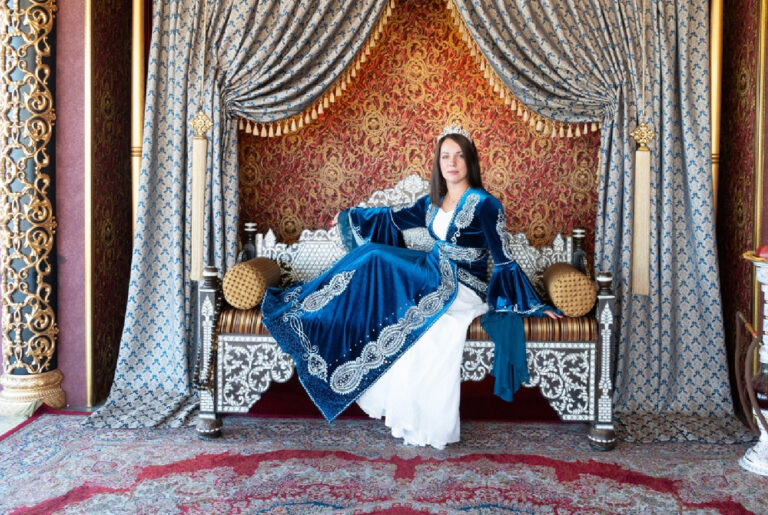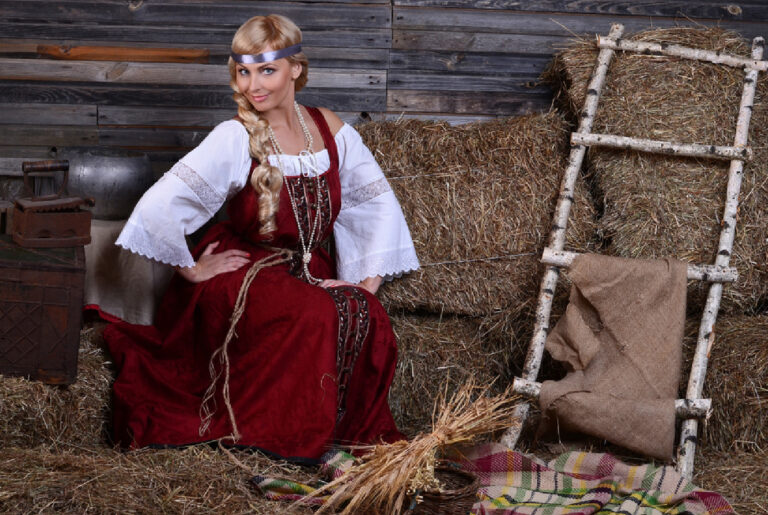
Hello fashion enthusiasts! In today’s post, we will take an in-depth look at the traditional clothing of various countries, exploring the rich cultures and histories behind each one. Under this blog heading, as we examine traditional garments from different regions of the world, we will discover the vibrancy and diversity of different cultures. Traditional clothing is a significant element that reflects traditions carried from the past to the present, each with its own unique features. Let’s embark together on this cultural, historical fashion adventure. If you’re ready, let’s begin!
Traditional Clothing of Azerbaijan:

1. Azerbaijan – Kelaghayi
Azerbaijan’s traditional clothing, culture is typically characterized by colorful and embroidered details. The most important garment for women is a headscarf usually made of silk and adorned with patterns in various colors. This headscarf is called “kelaghayi” and is often worn in everyday life as well as on special occasions. Azerbaijani women also frequently wear embroidered dresses and shawls.
Traditional Clothing of Turkey:

2. Turkey – Bindalli and Kaftan
Turkish traditional clothing, has been shaped by various cultural influences throughout its history. Important garments for women include the “bindallı” or “kaftan.” Bindallı is a richly embroidered dress typically worn at weddings and special ceremonies. Additionally, in everyday life, Turkish women prefer more comfortable yet stylish clothing such as “şalvar” (baggy trousers) and “cepken” (a type of jacket).
Traditional Clothing of Italy:

3. Italy – Coppola
Italy’s traditional clothing, culture varies according to its geographical regions. In Southern Italy, women typically wear blouses paired with colorful and patterned skirts for the “tarantella” dance. Additionally, in Sicily, women wear a round hat called the “coppola.” In the northern regions of Italy, patterned swimwear called “traje da bagno” is popular along the seaside.
Traditional Clothing of Japan:

5. Japan – Kimono
Japanese traditional clothing is recognized by the “kimono.” The kimono is typically a long, wide-sleeved garment made of silk. Its colors and patterns vary according to the season and occasion. Worn during special ceremonies and celebrations, the kimono is a symbol of Japanese culture and is often preserved as a family heirloom.
Traditional Clothing of China:

6. China – Cheongsam and Qipao
China’s traditional clothing is known as “qipao” or “cheongsam.” The qipao is a form-fitting dress usually made of silk, featuring a high collar and button closures. Its patterns often carry symbolic meanings and reflect Chinese aesthetics. Additionally, China has a variety of traditional garments that vary by region.
Traditional Clothing of Scotland:

7. Scotland – Kilt
The traditional Scottish garment, the “kilt,” is typically worn by men and is a symbol of the country. The kilt is designed as a pleated skirt with multiple layers. Its colors and patterns are often customized to reflect family or clan tartans and are worn on special occasions, such as weddings and festivals.
Traditional Clothing of Russia:

8. Russia – Sarafan
Russia’s traditional clothing culture often features richly embroidered details. An important garment for women is the “sarafan.” The sarafan consists of a long skirt combined with a blouse. Its colors and patterns reflect the depths of Russian culture and are typically worn on special days and during celebrations.
Traditional Clothing of India:

9. India – Sari, Salwar Kameez, Lehenga Choli
India’s traditional clothing is renowned worldwide for its rich colors, intricate patterns, and deep meanings. Here are three significant garments that reflect India’s cultural richness:
1. Sari:
The sari, one of India’s most famous garments, is a long piece of cloth made from cotton, silk, or synthetic materials. Its colors and patterns vary regionally and are typically worn at weddings and festivals.
2. Salwar Kameez:
Another popular traditional outfit for daily wear is the salwar kameez. The kameez is an embroidered long tunic, while the salwar is a wide and comfortable pant. The dupatta, a long scarf, completes the outfit.
3. Lehenga Choli:
Popular at weddings, the lehenga choli consists of a long skirt (lehenga) adorned with heavy embroidery and a matching blouse (choli). This attire reflects India’s elegance and cultural heritage.
Traditional Clothing of Africa:

10. Africa – Buba and Wrapper
The African continent boasts a wide range of cultural diversity, with each region having its own traditional clothing styles. For instance, in Nigeria, women typically wear colorful and patterned “buba” and “wrapper” garments. The buba is usually a long-sleeved, loose-fitting top, while the wrapper is a wide piece of fabric used as a wrap-around skirt.
In this article, we introduced traditional women’s garments from various cultures around the world. Each of these outfits carries its own story and significance, reflecting the cultural richness and aesthetic sensibilities of their respective countries. Are you ready to explore this vibrant world? For more information on the richness and cultural depth of traditional clothing, feel free to check out the links. Enjoy your exploration, and stay fashionable!







Leave a Reply